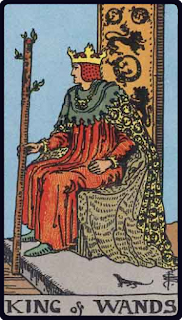
Representing the paternal nature; the King of Wands represents the finality of creation with the embodiment of the burden of service and the responsibility of governance. The King of Wands represents our ownership of our creative output and the obligation we create within ourselves when releasing this creativity into the world. We become King of the domain we created and serve as the authority for those who enter into it.
In the upright state the King of Wands represents the sacrifice of self-interest and in many ways the death of the author; we are called upon to recognise which elements of our creation still fall within our domain, and release those that fall beyond it. Knowing what we can control and influence is the focus here.
In the inverted state the King of Wands represents our attempt to govern that which cannot be governed. The King of Wands represents the extension of our authority beyond our domain and the futility or potential repercussions of that action. The focus here is not to overreach and to rein back our ambitions; an inverted King of Wands is often a sign of our inability to recognise the death of the author, dismissing the life of its own that our creation has taken on, fuelled by the arrogant desire to remain in complete control, refusing to let go.
In the Rider-Waite deck the King’s throne has no guards on his armrests representing the independence of being, the King is alone in his outlook. Beside his throne a single gecko can be seen looking up at the King, representing the reptilian mind and cold heart of reason. The King sits once more with a single Wand in his hand representing his wisdom and experience but no offering is held in his other hand, serving to represent his authority and dominion being his only offering.
Behind the King three reptiles are depicted once more, this time each forms a complete Ouroboros representing the achievement of iteration and recursion. The legacy of the King is already assured, their position and power absolute; their wisdom further reinforced by the arrangement of these three figures placed in an inverted triangle representing the feminine nature of creation. The legacy of power and authority of the King is assured in death as the heir ascends the throne, whether that be his own offspring or that of another, the Crown will survive beyond the life of the King.
Finally contained within this inverted triangle is a single lion representing the King in repose; a second lion can be seen by the King’s shoulder, with the assumption that a third sits at the other side, together these form an upright triangle, these three lions represent the juxtaposition of the masculine nature of destruction and a reminder that man’s greatest threat is often himself, the downfall of a King lies in his failure to govern.
In self-reflection the King of Wands asks us to consider your openness and your secrecy and reflect on how much of your creative process and how much action you want to share with others. Knowing when to protect yourself from outside influence and protect your work from those who would take it from you and pass it off as their own is an important part of collaboration. Whilst your intent may be pure, the intentions of others may not always be what you expect.
Ask yourself “Who could have helped me with this?” and “Did I really need to do that myself?” the focus here is on the element of trust, and the ability to identify who you can trust to help and who you should avoid. This could be taken as individuals or it could be taken as non-corporeal sources of information, references, and media that you can consume.

No comments:
Post a Comment
All comments are moderated before they are published. If you want your comment to remain private please state that clearly.